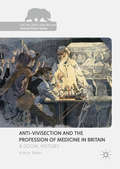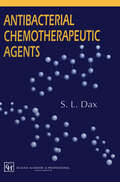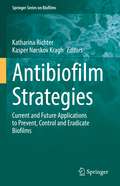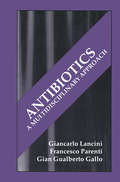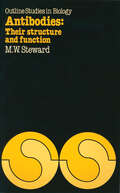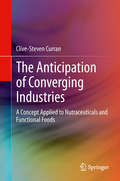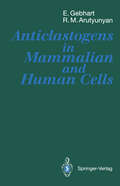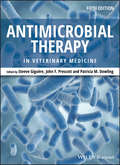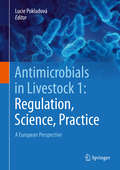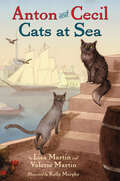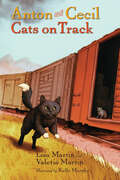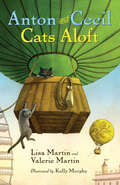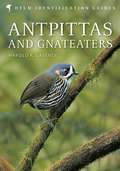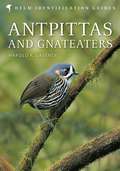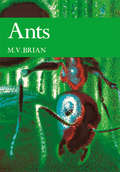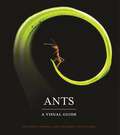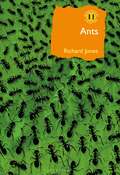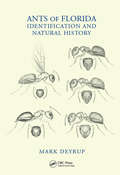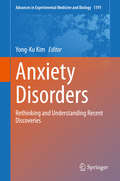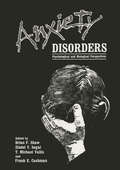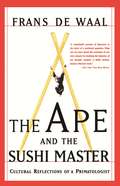- Table View
- List View
Anti-Vivisection and the Profession of Medicine in Britain: A Social History (The Palgrave Macmillan Animal Ethics Series)
by A.W.H. BatesThis book is open access under a CC BY 4.0 license.This book explores the social history of the anti-vivisection movement in Britain from its nineteenth-century beginnings until the 1960s. It discusses the ethical principles that inspired the movement and the socio-political background that explains its rise and fall. Opposition to vivisection began when medical practitioners complained it was contrary to the compassionate ethos of their profession. Christian anti-cruelty organizations took up the cause out of concern that callousness among the professional classes would have a demoralizing effect on the rest of society. As the nineteenth century drew to a close, the influence of transcendentalism, Eastern religions and the spiritual revival led new age social reformers to champion a more holistic approach to science, and dismiss reliance on vivisection as a materialistic oversimplification. In response, scientists claimed it was necessary to remain objective and unemotional in order to perform the experiments necessary for medical progress.
Antibacterial Chemotherapeutic Agents
by S.L. DaxOver the past 50 years a wide variety of antibacterial substances have been discovered and synthesised, and their use in treating bacterial infection has been spectacularly successful. Today there are several general classes of antibacterial drugs, each having a well established set of uses, and together they form the mainstay of modern antibacterial chemotherapy. In search for new and improved agents, the pharmaceutical researcher needs to be well informed on many topics, including existing agents, their modes of action and pharmacology, and possible synthetic approaches. In this new book the author has brought together a wide range of information on the principal classes of antibacterial agents, and he covers, for each group, their history, mode of action, key structural features, synthesis and bacterial resistance. The result is a compact and concise overview of these very important classes of antibacterial agents.
Antibiofilm Strategies: Current and Future Applications to Prevent, Control and Eradicate Biofilms (Springer Series on Biofilms #11)
by Katharina Richter Kasper Nørskov KraghBacteria and fungi are able to aggregate together or on surfaces in densely packed microcolonies, facilitated by extracellular polymeric substances for cell protection and stability. These biofilms have proven to be extremely hard to eradicate and remove once established. In chronic infections, this condition can result in a high degree of morbidity and mortality as regular antibiotic treatments are ineffective against biofilms. In industrial facilities, the formation of biofilms can ruin production and result in enormous financial losses. In this book, the current state of antibiofilm research is presented by experts from around the world. Novel, cutting-edge techniques and new optimized strategies based on established methods are discussed in chapters focused on biofilm prevention, treatment and control for the application in clinical, industrial and veterinary settings. Antibiofilm strategies, such as chemical and enzymatic treatments, surface modification and coatings, quorum sensing inhibition and dispersal induction, phage therapy, cold plasma treatment, hyperbaric oxygen treatment, and metal-based nanomedicine are covered, among many others. This book contributes to the UN’s Sustainable Development Goal 3: Good Health and Well-Being and is a valuable resource for healthcare professionals, microbiologists, academics and for educators to inform curricula of universities and colleges.
Antibiotics: A Multidisciplinary Approach
by G.G. Gallo G. Lancini F. ParentiIn this translation of the Italian second edition, the authors provide a comprehensive account of the current knowledge on antibiotics. They concisely describe how various scientific disciplines are involved in antibiotics research, development, and use. Their work also discusses the industrial and clinical development of new antibiotics, as well as the questions and controversies related to the function of antibiotics in nature. Antibiotics is richly illustrated with clear chemical structures, drawings, diagrams, and synoptical tables.
Antibodies: Their structure and function
by M.W. StewardThe student of biological science in his final years as an undergraduate and his first years as a graduate is expected to gain some familiarity with current research at the frontiers of his discipline. New research work is published in a perplexing diversity of publications and is inevitably con cerned with the minutiae of the subject. The sheer number of research journals and papers also causes confusion and difficulties of assimilation. Review articles usually presuppose a background knowledge of the field and are inevitably rather restricted in scope. There is thus a need for short but authoritative introductions to those areas of modern biological research which are either not dealt with in standard introductory textbooks or are not dealt with in sufficient detail to enable the student to go on from them to read scholarly reviews with profit. This series of books is designed to satisfy this need. The authors have been asked to produce a brief outline of their subject assuming that their readers will have read and remembered much of a standard introductory textbook of biology. This outline then sets out to provide by building on this basis, the conceptual framework within which modern research work is progressing and aims to give the reader an indication of the problems, both conceptual and practical, which must be overcome if progress is to be maintained.
The Anticipation of Converging Industries: A Concept Applied to Nutraceuticals and Functional Foods
by Clive-Steven CurranThe blurring of boundaries between hitherto distinct scientific disciplines, technologies or markets is a common and powerful phenomenon. Subjects of this convergence often change consumer behaviours, favouring products and platforms with multiple functions. The Anticipation of Converging Industries provides a detailed focus on the triggers, drivers and consequences of convergence to create a more concise definition of convergence. This detailed analysis includes a specifically developed toolbox for ‘convergence foresight’, creating a forecasting method for convergence trends. With the focus on the chemical, biotechnological and pharmaceutical industries, several indicators of convergence in the areas of Nutraceuticals/Functional Foods, Cosmeceuticals and ICT are derived from samples including over 1million patents and scientific publications. By supporting this methodical approach with real world data, The Anticipation of Converging Industries is perfect for industry practitioners looking for a competitive edge in the present and for the future. Similarly, academics will find a comprehensive theoretical concept for better understanding the underlying rationale of convergence at their disposal
Anticlastogens in Mammalian and Human Cells
by Erich Gebhart Ruben M. ArutyunyanAnticlastogens in Mammalian and Human Cells covers research on the protection of chromosomes from the action of chemical mutagens by use of natural and synthetic antimutagens, which, because of their specific action on clastogenic damage are called anticlastogens. Based on an introductory chapter on nature and mode of formation of chromosome aberrations induced by chemical and also physical mutagens, the action of anticlastogens is discussed in detail. A definition and delineation of the term anticlastogenesis is followed by considerations on the various possibilities of classifying anticlastogens. Attention is paid to the action of anticlastogens in mammalian and human cell culture systems, in vivo data on anticlastogens are presented in great detail, as are the actions of anticlastogens on induced sister chromatid exchanges in various test systems. A mainly historical side-glance at the action of anticlastogens on chromosome damage induced by ionizing radiation is taken. The practical consequences of the findings on anticlastogenic action are extensively discussed as aspects of further research.
Antimicrobial Therapy in Veterinary Medicine
by Steeve Giguère John F. Prescott Patricia M. DowlingThe Fifth Edition of Antimicrobial Therapy in Veterinary Medicine, the most comprehensive reference available on veterinary antimicrobial drug use, has been thoroughly revised and updated to reflect the rapid advancements in the field of antimicrobial therapy. Encompassing all aspects of antimicrobial drug use in animals, the book provides detailed coverage of virtually all types of antimicrobials relevant to animal health. Now with a new chapter on antimicrobial therapy in zoo animals, Antimicrobial Therapy in Veterinary Medicine offers a wealth of invaluable information for appropriately prescribing antimicrobial therapies and shaping public policy. Divided into four sections covering general principles of antimicrobial therapy, classes of antimicrobial agents, special considerations, and antimicrobial drug use in multiple animal species, the text is enhanced by tables, diagrams, and photos. Antimicrobial Therapy in Veterinary Medicine is an essential resource for anyone concerned with the appropriate use of antimicrobial drugs, including veterinary practitioners, students, public health veterinarians, and industry and research scientists.
Antimicrobial Therapy in Veterinary Medicine
by Steeve Giguère John F. Prescott Patricia M. DowlingThe Fifth Edition of Antimicrobial Therapy in Veterinary Medicine, the most comprehensive reference available on veterinary antimicrobial drug use, has been thoroughly revised and updated to reflect the rapid advancements in the field of antimicrobial therapy. Encompassing all aspects of antimicrobial drug use in animals, the book provides detailed coverage of virtually all types of antimicrobials relevant to animal health. Now with a new chapter on antimicrobial therapy in zoo animals, Antimicrobial Therapy in Veterinary Medicine offers a wealth of invaluable information for appropriately prescribing antimicrobial therapies and shaping public policy. Divided into four sections covering general principles of antimicrobial therapy, classes of antimicrobial agents, special considerations, and antimicrobial drug use in multiple animal species, the text is enhanced by tables, diagrams, and photos. Antimicrobial Therapy in Veterinary Medicine is an essential resource for anyone concerned with the appropriate use of antimicrobial drugs, including veterinary practitioners, students, public health veterinarians, and industry and research scientists.
Antimicrobials in Livestock 1: A European Perspective
by Lucie PokludováThis first volume in a two-volume work enhances readers’ understanding of antimicrobial resistance mechanisms in selected bacterial species that cause diseases in major food producing animals. It provides an overview of the current legislation and policies seeking to regulate the authorisation, manufacturing, distribution and use of veterinary antimicrobials in practice in a way that helps to contain the spread of antimicrobial resistance. The focus is put on Europe, without neglecting the global context. Moreover, attention is paid to various uses of antimicrobials in livestock, considering both their risks and benefits, from the distant past to the present. Growth promotion, prophylaxis, metaphylaxis, diagnostics and treatment are discussed not only with regard to food production and animal health, but also considering the One Health concept, which combines public and animal health with environmental aspects. A summary of various systems for monitoring the use of antimicrobials is provided, as well as an overview of the diseases that European veterinarians most often treat with antimicrobials. In closing, the book addresses the complexity of recent measures that are of key importance for antimicrobial stewardship, e.g. biosecurity, vaccination and other preventive tools including the newest technologies like smart farming. The complete two-volume work provides an extensive review of various aspects related to the use of antimicrobials in veterinary medicine, especially considering major food producing species, their most common infectious diseases and causative pathogens, and mainly focusing on the situation in Europe, without ignoring the global context. While Volume I discusses more general aspects of antibiotic use such as regulatory, laboratory and practical issues from different perspectives, Volume II more specifically discusses medical aspects and the use of antimicrobials in cattle, pigs, poultry and horses, as well as pharmacokinetics and pharmacodynamics, two of the most important factors determining the success of treatment. In both volumes, each chapter confronts the reader with open questions to stimulate further discussions and future research on the topics covered.
Anton and Cecil, Book 1: Cats at Sea (Anton and Cecil #1)
by Lisa Martin Valerie MartinWhen Anton is stolen off the dock, the next thing he knows, he&’s at sea. Knowing little of the wide open ocean, brave Cecil boards another ship to find his brother. But what begins as a rescue mission turns into a pair of high seas adventures, with thrills and danger bubbling under every wave.
Anton and Cecil, Book 2: Cats on Track (Anton and Cecil #2)
by Lisa Martin Valerie MartinThe adventurous cats who sailed the open seas in Anton and Cecil: Cats at Sea head west by train to rescue a missing mouse friend. With few clues, the two depend on the help of prairie dogs, bison, ferrets, and a wise lynx to solve the mystery of Hieronymus&’s whereabouts.
Anton and Cecil, Book 3: Cats Aloft (Anton and Cecil #3)
by Lisa Martin Valerie MartinIn the thrilling final adventure of the critically acclaimed trilogy, cat brothers Anton and Cecil team up with a police dog to search for puppies stolen right off their leashes at the Chicago World&’s Fair.
Antpittas and Gnateaters
by Harold Greeney David BeadleElusive study organisms for ornithologists and highly prized additions to the birder's life-list, the antpittas (Grallariidae) and gnateaters (Conopophagidae) are among the most poorly known Neotropical bird groups. This authoritative handbook is the first book dedicated solely to these two families, combining an exhaustive review of more than two centuries of literature with original observations by the author and many knowledgeable contributors. Antpittas and Gnateaters provides a thorough guide to the identification and ecology of these birds, with detailed maps accompanying the text. A series of superb plates illustrate most of the 156 recognized taxa; supplemented by more than 250 colour photographs, the immature plumages and natural history of many species are depicted for the first time. This book is the ultimate reference on these remarkable and beautiful birds, and an indispensible addition to the libraries of researchers and birders for many years to come.
Antpittas and Gnateaters
by Harold Greeney David BeadleElusive study organisms for ornithologists and highly prized additions to the birder's life-list, the antpittas (Grallariidae) and gnateaters (Conopophagidae) are among the most poorly known Neotropical bird groups. This authoritative handbook is the first book dedicated solely to these two families, combining an exhaustive review of more than two centuries of literature with original observations by the author and many knowledgeable contributors. Antpittas and Gnateaters provides a thorough guide to the identification and ecology of these birds, with detailed maps accompanying the text. A series of superb plates illustrate most of the 156 recognized taxa; supplemented by more than 250 colour photographs, the immature plumages and natural history of many species are depicted for the first time. This book is the ultimate reference on these remarkable and beautiful birds, and an indispensible addition to the libraries of researchers and birders for many years to come.
Ants (Collins New Naturalist Library #59)
by M. V. BrianAnts should provide both the amateur naturalist and the professional zoologist with a valuable source of reference, and a fascinating account of the lives of an intriguing group of insects.
Ants: A Visual Guide
by Heather Campbell Benjamin BlanchardA richly illustrated natural history of ants, covering their diversity, ecology, anatomy, behavior, and morePlentiful and familiar, ants make up an estimated one-third of the world’s insect biomass and can be found in virtually every part of the globe, from rain forest canopies to city sidewalks. But their importance is about more than numbers: ants are fundamental species in a range of habitats and their interactions with plants, fungi, and other animals ensure the survival of many fragile and complex ecosystems. This beautifully illustrated book explores the extraordinary diversity of ants and offers insights into their elaborate social systems, investigating the key collective and competitive behaviors that operate within their varied colony structures.Featuring exceptional close-up photographs and clearly organized thematic chapters, the book covers anatomy, evolution, life cycle, ecology, and other important topics. Each chapter also features profiles of standout genera, chosen for their fascinating characteristics, including Leafcutter Ants, who build nests containing up to 7,000 chambers; Pugnacious Ants whose colonies can destroy populations of crabs within hours; and Honeypot Ants whose worker caste store food in their stomachs for other colony members to consume. Drawing on current research, Ants offers an inviting and accessible introduction to these remarkable insects.Includes more than 200 stunning color photographs, plus infographics and diagramsPresents full profiles of 42 iconic genera from across the worldFeatures clearly structured thematic chapters
Ants: The ultimate social insects (British Wildlife Collection)
by Richard Jones'Brilliant, Fantastic and Significant' - Dr George McGavinAnts are seemingly everywhere, and this familiarity has led to some contemptuous and less than helpful stereotypes. In this compelling insight into the natural and cultural history of ants, Richard Jones helps to unravel some of the myths and misunderstanding surrounding their remarkable behaviours. Ant aggregations in large (often mind-bogglingly huge) nests are a complex mix of genetics, chemistry, geography and higher social interaction. Their forage trails – usually to aphid colonies but occasionally into the larder – are maintained by a wondrous alchemy of molecular scents and markers. Their social colony structure confused natural philosophers of old and still taxes the modern biologist today. Beginning the book with a straightforward look at ant morphology, Jones then explores the ant species found in the British Isles and parts of nearby mainland Europe, their foraging, nesting, navigating and battle instincts, how ants interact with the landscape, their evolution, and their place in our understanding of how life on earth works. Alongside this, he explores the complex relationship between humans and ants, and how ants went from being the subject of fables and moral storytelling to become popular research tools. Drawing on up-to-date science and featuring striking colour photographs throughout, this book presents a convincing case for why ants are worth our greater recognition and respect.
Ants: The ultimate social insects (British Wildlife Collection)
by Richard Jones'Brilliant, Fantastic and Significant' - Dr George McGavinAnts are seemingly everywhere, and this familiarity has led to some contemptuous and less than helpful stereotypes. In this compelling insight into the natural and cultural history of ants, Richard Jones helps to unravel some of the myths and misunderstanding surrounding their remarkable behaviours. Ant aggregations in large (often mind-bogglingly huge) nests are a complex mix of genetics, chemistry, geography and higher social interaction. Their forage trails – usually to aphid colonies but occasionally into the larder – are maintained by a wondrous alchemy of molecular scents and markers. Their social colony structure confused natural philosophers of old and still taxes the modern biologist today. Beginning the book with a straightforward look at ant morphology, Jones then explores the ant species found in the British Isles and parts of nearby mainland Europe, their foraging, nesting, navigating and battle instincts, how ants interact with the landscape, their evolution, and their place in our understanding of how life on earth works. Alongside this, he explores the complex relationship between humans and ants, and how ants went from being the subject of fables and moral storytelling to become popular research tools. Drawing on up-to-date science and featuring striking colour photographs throughout, this book presents a convincing case for why ants are worth our greater recognition and respect.
Ants of Florida: Identification and Natural History
by Mark DeyrupAnts are familiar to every naturalist, ecologist, entomologist, and pest control operator. The identification of the 233 species of Florida ants is technically difficult, and information on Florida ants is dispersed among hundreds of technical journal articles. This book uses detailed and beautiful scientific drawings for convenient identification. To most Florida biologists ants are currently the most inaccessible group of conspicuous and intrusive insects. This book solves the twin problems of ant identification and the extraordinary fragmentation of natural history information about Florida ants.
Ants of Florida: Identification and Natural History
by Mark DeyrupAnts are familiar to every naturalist, ecologist, entomologist, and pest control operator. The identification of the 233 species of Florida ants is technically difficult, and information on Florida ants is dispersed among hundreds of technical journal articles. This book uses detailed and beautiful scientific drawings for convenient identification. To most Florida biologists ants are currently the most inaccessible group of conspicuous and intrusive insects. This book solves the twin problems of ant identification and the extraordinary fragmentation of natural history information about Florida ants.
Anxiety Disorders: Rethinking and Understanding Recent Discoveries (Advances in Experimental Medicine and Biology #1191)
by Yong-Ku KimThis book reviews all important aspects of anxiety disorders with the aim of shedding new light on these disorders through combined understanding of traditional and novel paradigms. The book is divided into five sections, the first of which reinterprets anxiety from a network science perspective, examining the altered topological properties of brain networks in anxiety disorders. The second section discusses recent advances in understanding of the neurobiology of anxiety disorders, covering, for example, gene-environmental interactions and the roles of neurotransmitter systems and the oxytocin system. A wide range of diagnostic and clinical issues in anxiety disorders are then addressed, before turning attention to contemporary treatment approaches in the context of novel bio-psychosocial-behavioral models, including bio- and neurofeedback, cognitive behavioral therapy, neurostimulation, virtual reality exposure therapy, pharmacological interventions, psychodynamic therapy, and CAM options. The final section is devoted to precision psychiatry in anxiety disorders, an increasingly important area as we move toward personalized treatment.Anxiety Disorders will be of interest for all researchers and clinicians in the field.
Anxiety Disorders: Psychological and Biological Perspectives
by Brian F. ShawAnxiety is one of those entltles which everyone "knows", but which ultimately resists simple objective description. The essence of the phenomenon is its subjectivity. True it has its well documented associated physiological events: the increased pulse rate and blood pressure, sweating, and so on, but each of these phenomena may also be part of physical exertion, fear, or even pleasurable excitement. They cannot fully define the sense of threat, danger, collapse, malignancy in greater or smaller amount, in greater or lesser locali sation, with more or less objective evidence for its validity that characterises the particular psychological pain we all recognize as anxiety. It is precisely the essential subjectivity of anxiety and its association with an enormous range of experience that makes it difficult to assign to it well-defined diagnostic labels of the kinds so carefully described by Dr. Spitzer in his chapter on classification. His chapter ranges from the extreme dread of "Panic Disorders", to the diffuse terror of the environment which used to be labelled "Agoraphobia" (and is still so called in the day to day pragmatic usage of many clinics) and is not assimilated to the class of phobias with the label "Social Phobias". He also addresses the "Simple Phobias" which are perhaps the most readily labelled of the many varieties of anxiety.
The Ape And The Sushi Master: Cultural Reflections Of A Primatologist
by Frans De WaalFrom the New York Times bestselling author of Mama's Last Hug and Are We Smart Enough to Know How Smart Animals Are?, a provocative argument that apes have created their own distinctive culturesIn The Ape and the Sushi Master, eminent primatologist Frans de Waal corrects our arrogant assumption that humans are the only creatures to have made the leap from the natural to the cultural domain. The book's title derives from an analogy de Waal draws between the way behavior is transmitted in ape society and the way sushi-making skills are passed down from sushi master to apprentice. Like the apprentice, young apes watch their group mates at close range, absorbing the methods and lessons of each of their elders' actions. Responses long thought to be instinctive are actually learned behavior, de Waal argues, and constitute ape culture. A delightful mix of intriguing anecdote, rigorous clinical study, adventurous field work, and fascinating speculation, The Ape and the Sushi Master shows that apes are not human caricatures but members of our extended family with their own resourcefulness and dignity.
Ape Skeleton (UEB uncontracted)
by Adrian FarnsworthThis page shows an image of an ape skeleton shown from the side, facing to the left and standing on all four legs.
